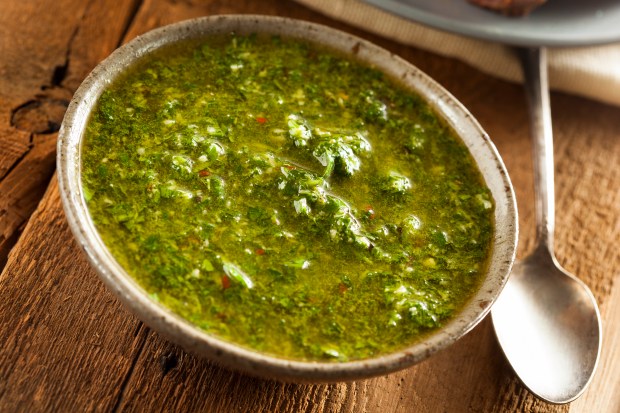Want a taste of Argentina’s favorite street food? Slice a sizzling chorizo down the middle, crush it into some crusty French bread, drench it in bright, flavorful chimichurri sauce, and take a bite. Chew slowly, allowing the succulent sausage to bleed into the bread until the juices run together with the sauce. Perfection.
Known as choripán (chori being a diminutive of chorizo, pan being Spanish for bread), a whopping 600 million of these tasty sausage sandwiches are reportedly devoured each year in Argentina. That’s an average of 15 choripanes a year per person, an impressive figure even in a land where meat is king.
In fact, choripán is so deeply entrenched in popular culture that during last year’s presidential election, former President Cristina Kirchner accused an opposition candidate of receiving a golden choripán. This was quite a statement as choripanes were closely associated with vote-buying—the sandwiches were said to have been handed out quite freely during political events. By invoking the golden choripán, Mrs. Kirchner was insinuating corruption on a grander scale.
But enough of politics. Offered street-side throughout Buenos Aires and considered a ritual meal before fùtbol matches, choripán is an Argentine classic that—like the country that adores it—is rooted in the wild beauty of the land and the European immigrants that resettled, and forever redefined, the nation.
And who brings that together best but the gauchos, herdsmen of mixed European and indigenous descent that roamed the pampas of Argentina. No one knows who the genius was who first put chorizo onto bread and anointed it with chimichurri sauce, but the sandwich is part of the fabric of Argentine life. Traditionally enjoyed at the beginning of an asado, another Argentine ritual that involves grilling beef for hours over a low flame, choripán soon made its way from the Argentine wilderness to the nation’s big cities, then on to Uruguay, Brazil, Chile, and finally, to your house. And no choripán is complete without some killer chimichurri.
Classic Argentine Chimichurri Sauce
The origins of chimichurri sauce are unclear. Some say it was created by an Irishman, James McCurry, whose name was converted into Yim Churri. Others chalk it up to the invading British, whose taste for curry following the colonization of India was well-known; proponents of this theory often point to the similarity between chimichurri and “Give me the curry!” Others claim chimichurri comes from the Basque word tximitxurri, which means jumble, or mixture.
The truth is probably a tximitxurri of all the above. At any rate, making your own choripán isn’t hard — all you need is some fresh French bread, chorizo (if you can’t find chorizo in your local supermarket, check any Mexican markets in your area), and that bombshell of a sauce, chimichurri:

Ingredients:
(Makes enough to drench about a dozen choripánes)
1 1/2 cups olive oil
1/4 cup white wine vinegar
1 cup finely-chopped fresh parsley
1/2 teaspoon cayenne pepper
1/2 teaspoon paprika
1/2 teaspoon oregano
1/4 teaspoon black pepper
2 cloves garlic, finely chopped
Juice of half a lemon
Salt, to taste
Preparation:
Fastest and easiest is put everything in a food processor and process until it’s sauce-like, but that method tends to work everything so uniformly you’re almost certain to lose complexity. The recommended way is to mince the garlic and the parsley by hand, and add it in after you’ve mixed everything else by either food processor or hand. The recipe above is for classic chimichurri, but there are many variants, such as tomato chimichurri (add onion and sundried tomatoes), cilantro chimichurri (add onion and substitute the parsley for cilantro), garlic chimichurri (use half a head of garlic and add bay leaves, and yes, bay leaves are edible, they’re not just for sticking in stews), and so on. Of course, nothing’s stopping you from making up your own!